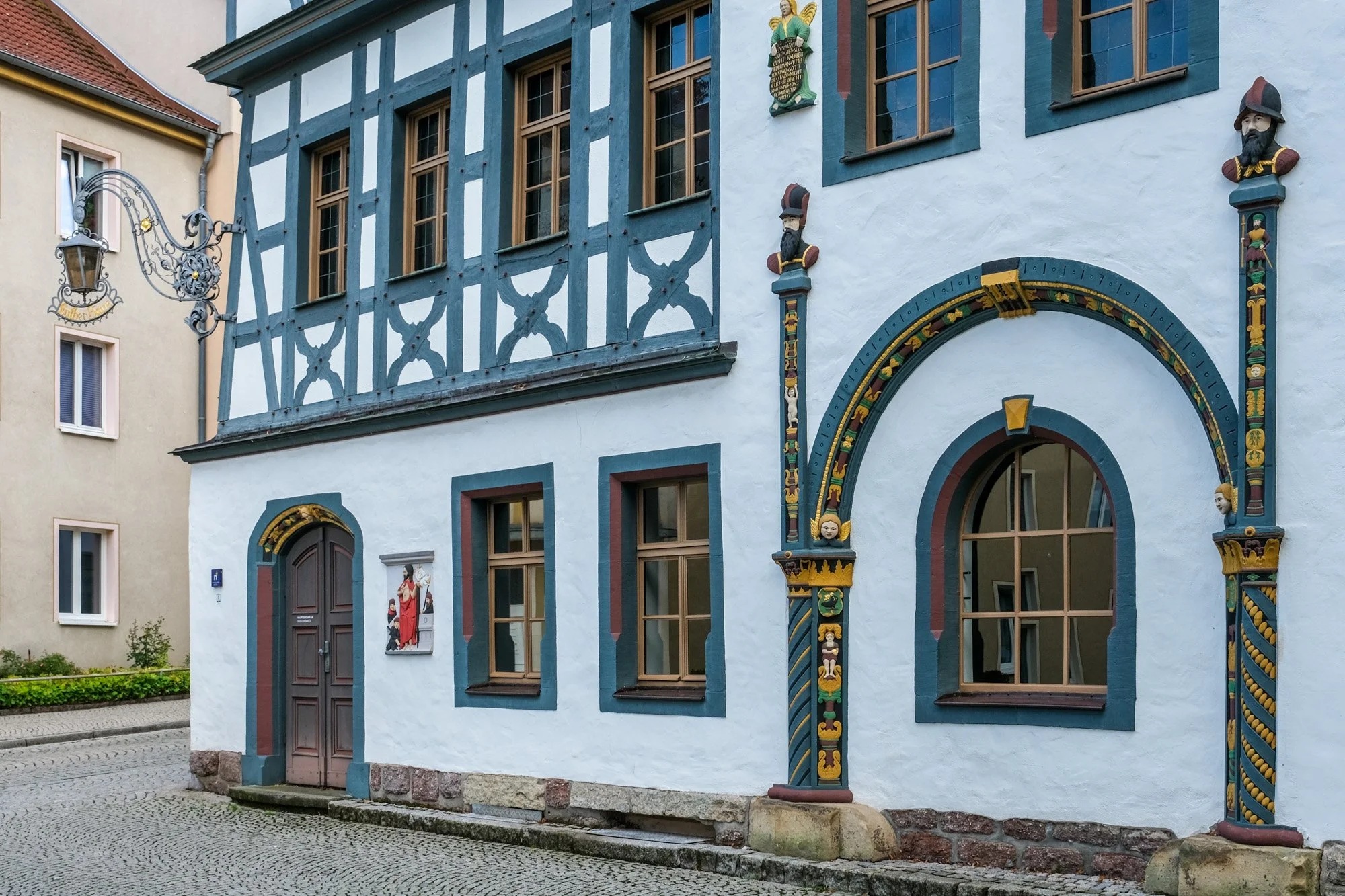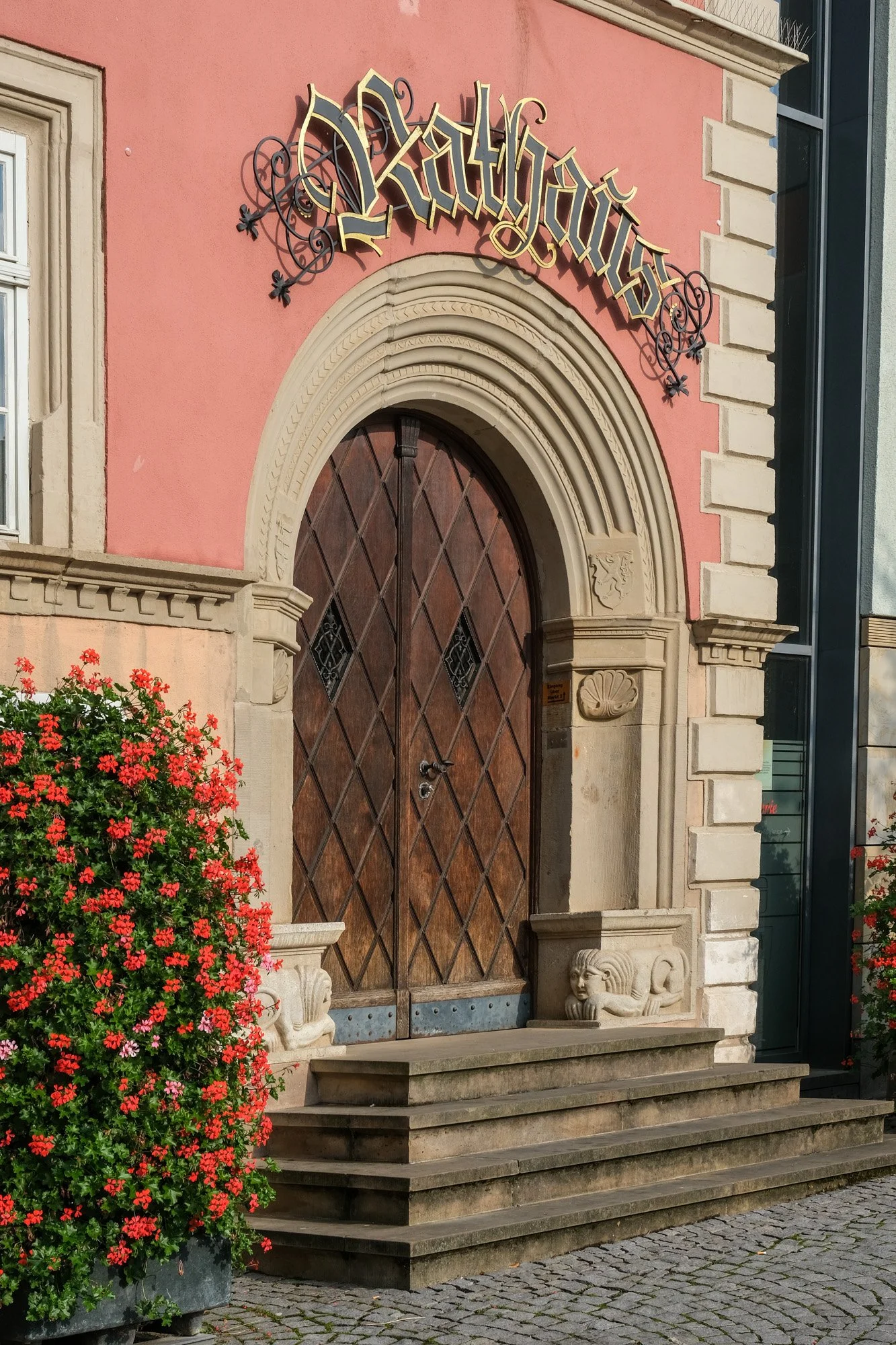Eisenach - The Town of Luther and Bach
The final stop on our Martin Luther pilgrimage was the town of Eisenach in the geographic center of modern Germany. Although we were both slightly numbed by the numerous Luther sites by the time we arrived at Eisenach, I was quickly jolted by the understated charm of this town of forty thousand. Most visitors are drawn here by the association with the Protestant reformer, notably the famous Wartburg Castle, one of Germany’s fifty-five UNESCO World Heritage Sites. I admit that Eisenach first caught my attention during trip planning because of my unhealthy habit of “collecting” world heritage sites. But I am happy to report that Eisenach turned out to be my favorite on this trip
Approximately a forty-minute drive west of Erfurt, this town of forty thousand is set in the rolling hills of Thuringia. In hindsight, I would have loved to spend a night in Eisenach to do the town justice. Based on my observations, most visitors make a beeline for the Wartburg Castle and barely visit the town center. Eisenach has enough interesting sites to fill a whole-day itinerary for most travelers. With so many great towns in the region, trip planning can be quite a challenging task.
The Bachhaus
The weather was not great when we first arrived at Eisenach. We used this opportunity to visit the town’s most popular museum: the Bachhaus. The childhood home of the famed Baroque composer Johann Sebastian Bach, this house museum is the preeminent institution dedicated to the life of Eisenach’s most famous native. Situated on a charming square a short walk from the town center, the museum is anchored by a massive half-timbered house that was home to the Bach family for generations. Dated to the mid-fifteenth century, this is actually the oldest surviving residential building in Eisenach.
Johann Sebastian Bach was born in Eisenach in 1685 and spent the first ten years of his childhood here. The Bach family had already been a multi-generational musical family in Eisenach and was well-known for their musical talents in town. The young Bach was particularly influenced by his uncles, who were the town church’s organists and the court musician of the Duchy of Saxe-Eisenach. Bach also attended the local Latin School, which also claimed Martin Luther as an alum. The young Bach lost his father at the age of nine and his mother a year later. He moved to nearby Ohrdruf to stay with his oldest brother, a celebrated organist in his own right.
From what I understand, Bach did not spend much time in Eisenach after he left. Today, the composer is most closely associated with Weimar and Leipzig. But that did not prevent the town from claiming him as its most famous son. The Bachhaus was owned by the headmaster of the Latin School at the time, and was occupied by Bach’s relatives until 1779. Roughly a century after Bach’s death, there is a resurgence in interest in all things Bach. In the nineteenth century, a group of musicians and cultural figures in Leipzig founded the Bach Society to publish the complete works of Bach and conduct research on his life. Among the founders of the society was the celebrated composer, Robert Schumann.
The Bach Society later reorganized into the New Bach Society in 1900. Among the new missions of the reconstituted society was to create a Bach museum. Their preferred venue was the Saint Thomas’s School in Leizpieg, where Bach lived and worked for 27 years. However, the city decided to demolish the building in 1902, forcing them to look for an alternative site. Thankfully, the original door to Bach’s room was saved and now features prominently at the entrance of today’s museum's permanent exhibit. As it turns out, the Bachhaus was up for possible demolition by the owners. With broad support from the local ruler and cultural figure, the society was quick to rescue the building from the wrecking balls.
Bach was a deeply religious man and devoted to Martin Luther’s teaching. His interests in Lutheranism stemmed from his education at the local Latin School, where Luther’s influences loomed large. The emphasis on music in Lutheran worship must have been a driving force behind his works and passions. In one of the rooms entitled Bach's Inner World, the exhibit reconstituted a section of Bach’s private theological library. Although he learned to play the violin and sing from an early age, he was foremost a composer and an organist. He spent much of his career in the service of the church.
The Bachhaus opened as a museum in 1907 and was the world’s first Bach museum, attracting generations of music lovers ever since. Sadly, the building suffered from severe damage during the Allies’ air raids in 1945. Luckily, the American commander occupying Eisenach recognized the historical significance of the house and ordered its immediate restoration. The museum received financial support from the GDR government during the Cold War. In 2007, the museum annex adjacent to the Bauhaus was rebuilt into a state-of-the-art facility with the assistance of the federal, state, and European Union governments. The avant-garde design by Berthold Penkhues was not without controversy.
Over the centuries, the building had settled significantly, and it has a slight fun-house effect. That said, the size of the house also speaks to the prosperity of the Bach family. Although the furnishings on display were only period pieces and not original to the Bach family, they offer visitors a glimpse into how the family might have used the house. That said, the museum contains numerous personal objects by Bach, including his eyeglasses and drinking vessels. Obviously, the precious items are Bach’s musical manuscripts.
Being a music museum, there are several rooms with listening booths. Music lovers could easily spend hours here to immerse themselves in Bach’s world. In the first section of the modern annex, there are half a dozen bubble chairs by Eero Aarnio. These iconic chairs may be transparent, but they offer visitors a cocoon feel. It was a great place to lose yourself in the music. The section adjacent includes numerous kiosks featuring musical videos that narrate and annotate some of Bach’s most famous works. They were beautifully executed, but given our limited time, I can’t help wishing the museum could make them available online so everyone could enjoy them virtually.
Brian was actually a trumpet performance major in college, so he was keen to see numerous wacky antique instruments on display. The most interesting instrument on display was the glass harmonica and a curious “trumpet violin,” a trumpet concealed within the body of a violin. Much to my surprise, Brian actually considered the Bachhaus as his favorite experience on this trip. The most exciting part of the visit was undoubtedly the hourly live demonstration of Baroque instruments. Among the instruments we got to hear are a positive organ, a seven-stringed viola da gamba, and a five-stringed violoncello piccolo. The little concert is true to the spirit of a music museum.
The garden of the Bachhaus is a tranquil oasis. It would have been amazing if the museum had Bach music played in the background. For those who don’t wish to pay the € 14 admission fee, it would still be worthwhile to admire the building's exterior and the Bach Monument out front. This handsome sculpture by Adolf von Donndorf initially stood in front of Saint George’s Church on the town square and was only moved here after the opening of the Bachhaus. Among the financial benefactors of the statue are notable figures such as Johannes Brahms, Franz Liszt, and Queen Victoria of the United Kingdom. Based on our visit, Bachmania is still thriving into the 21st century.
The Lutherhaus
A short walk away from the Bachhaus is Eisenach’s other landmark historical home: the Lutherhaus. As the name implies, the Lutherhaus was once the home of the Protestant reformer Martin Luther. Luther actually spent a considerable amount of time here throughout his life, and he often described it as “my beloved town.” Luther moved to Eisenach at the age of fifteen. Eisenbach was his mother’s hometown, and Luther initially stayed with relatives. Soon afterward, a local woman by the name Ursula Cotta took Luther in as he went door to door as a choirboy. She was one of the most influential women with a substantial property portfolio. It is widely believed
At a young age, Luther attended the parochial school at Saint George’s Church. Thanks to Cotta’s connections and influences, he immersed himself in lively discussions on religion, music, and the humanities. In total, he only spent three years in Eisenach before leaving for Erfurt to attend the university. However, he maintained contact with acquaintances here throughout his life. It must have been quite a comfort for Luther when he was abducted for his safety by Frederick the Wise to the nearby Wartburg Castle. I suspect he probably sneaked out of the castle from time to time to meet up with childhood friends.
The Lutherhaus was purchased by a local Renaissance master builder and was used as a brewery for some time. Because Luther only spent three years at the house, it did not become a center of Protestant pilgrimage like the Lutherhaus in Wittenberg or Luther’s Death House in Eisleben. The fanciful Renaissance half-timber facade was likely built after Luther’s time. The house passed from owner to owner frequently until the early modern period. The supposed “Luther’s Room” served more as a curiosity than a religious and historical artifact.
‘
Luckily, the Lutherhaus escaped the ravages of World War II relatively unscathed. After the war, the owner fled to West Germany, and the house was rented to the Evangelical Lutheran Church in Thuringia, which eventually acquired the ownership. The house gradually transforms into a historical museum. The permanent exhibition was considered state-of-the-art and served as the model for its counterpart in Wittenberg. The current museum was completely renovated a few years ago, just before the 500th anniversary of the posting of the Ninety-Five Thesis. It is now the second most visited landmark in town after the Bachhaus.
Unfortunately, the Lutherhaus was already closed during our visit, so we could only admire the grand building from the outside. I felt a little embarassed that I did get to both Lutherhaus on my Martin Luther pilgrimage. From my understanding, the exhibtion puts particular focus Luther’s translation due Eisenach’s proximity to Wartburg Castle. A multi-media exhibit gives visitors a glimpse in how Luther’s Bible impacted the vernacular Bibles throughout Eruope. I am certain Brian was giddy that I did not subject him of another Luther-related museum.
Old Town Eisenach
From the Lutherhaus, it was only a minute’s walk to the Market Square. The grand square is ringed by an impressive collection of civic architecture. Eisenach was situated at the intersection of several trade routes, making it a once-bustling commercial center. Formerly known as the Wednesday Market, this is one of the town’s three market squares. In the middle of the square is a gilded fountain of Saint George, the city’s patron saint. This beautiful fountain was actually moved several times throughout the centuries, most notably during the Nazi period, when the square was renamed after Adolf Hitler in 1933. The fountain was shoved aside to make way for military parades.
The most notable building is the Town Hall, a Renaissance-style structure featuring a characteristic clock tower. Eisenach. To its left is the City Palace, which was intended to be residence of the Dukes of Saxe-Eisenach and the Grand Dukes of Saxe-Weimar-Eisenach but was never occupied as such. The late-Baroque palace now hosts the city’s archive and the Thuringian Museum. The museum is reportedly home to an impressive collection of Rococo porcelain and a wide range of paintings from Eisenach and Thuringia. Despite the affordable admission, I can’t say the descriptions were exactly exciting to us. The more enticing branch of the Thuringian Museum would be the Reuter-Wagner Museum, which holds the most extensive collection of items related to composer Richard Wagner.
From a historical perspective, the most notable monument on the square is Saint George’s Church. As the main church of Eisenach, it witnessed numerous momentous historical events. It was the wedding venue of Saint Elizabeth of Hungary to Landgrave Ludwig IV, and where Martin Luther preached while “in hiding” at Wartburg Castle. Numerous rulers of Eisenach were buried in the crypt. However, the church is most closely associated with the Bach family, where the Bach family was baptized. Four members of the Bach family served as the organists of Saint George’s Church uninterrupted for over 130 years. The young Johann Sebastian Bach was first introduced to organ playing here.
As a Luther pilgrim, we were surprised that there aren’t too many Luther spots advertised here, except for the Lutherhaus. Given his positions on relics and saints, I suppose Luther would not approve of any active pilgrimage. Next to the Preacher’s Church is a concrete and glass memorial, entitled The Way, by local artist Hardy Raub. Having done the pilgrimage to Santiago, I immediately assumed it was either the Camino de Santiago or the Luther Trail. It was not until later that I discovered this sculpture is dedicated to Saint Elizabeth, the Hungarian princess who lived a life of charity and righteousness. We would learn more about Elizabeth's life during our visit to the nearby Wartburg Castle.
Eisenach was a major center of automotive manufacturing during the GDR times, with Opel being the most emblematic brand associated with the town. Automobile Welt Eisenach is a popular museum to this day. Like most small and mid-sized cities in East Germany, Eisenach experienced deindustrialization after unification. The opening in trade turned out to be an inadvertent curse for local industries due to the inherent inefficiency inherited from the socialist economy. Many young people moved west to work in the advanced industries of West Germany. The population plummeted by a third and never recovered. More than thirty years after unification, many East German cities still struggled economically.
This economic divide undoubtedly contributes to the rise of right-wing populism in contemporary Germany, as exemplified by the emergence of the Alternative for Germany (AfD) as the largest opposition party in the German Bundestag. In the most recent election, the AfD became the biggest political party in the Thuringian state parliament and Eisenach’s town council. It was the first time that a far-right party won a state parliament since the rise of Nazism. That said, they are barred from governing as no other political party is willing to be their coalition partners.
The prevailing pessimism in eastern Germany would have been an unexpected trajectory at the time of reunification. In 1998, President Bill Clinton made a stop in Eisenach as part of a state visit to commemorate the 50th anniversary of the Berlin Airlift. After visiting the Wartburg Castle and a nearby auto plant, the president made a speech on the Market Square to a massive crowd. In his remarks, he spoke about the American liberation of Eisenach and the restoration of the Bachhaus. While acknowledging the sacrifice and difficulty in rebuilding East Germany, he spoke extensively about the bright future that democracy and capitalist freedom had brought forward. Fast forward to 2025, and I can’t help feeling melancholic about the state of the world.
As a foreign visitor, it is undoubtedly challenging to discern the economic decline of the past thirty years during a casual visit to Eisenach. The town’s historic center is a charming place to admire the beautiful old buildings and to enjoy the relaxing ambiance. The main strolling street, Karlstraße, was bustling with life in the late afternoon. The local businesses here cater to locals, rather than tourists. While they might be interested in capturing more of the tourism dollars, Eisenach seemed like a great place to call home.




































